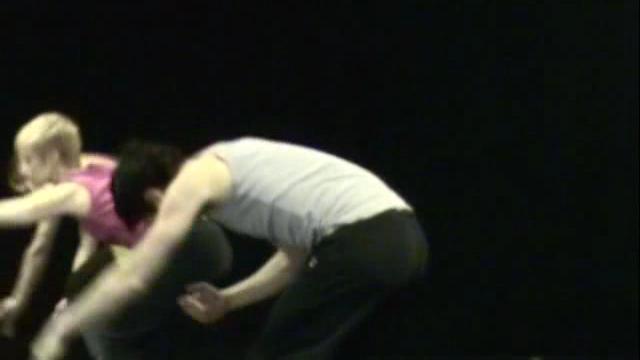
Modern dance was an early 20th century dance form that emerged as expression of rebellion against classical ballet. Pioneering dancers of this period include Isadora Duncan, who thought ballet was ugly and meaningless gymnastics and Martha Graham, who saw it was European, Imperialistic, and un-American.[1]
Isadora Duncan was a predecessor of modern dance and she virtually single-handedly restored dance’s rank among the arts with her free-flowing costumes, bare feet, loose hair, and using the torso as the catalyst for other movements. Born in San Francisco in 1877, she traveled and performed throughout Europe. She was a thinker and a poet who incorporated humor into her expression. Contributions she made are “natural movements inspired by classical Greek arts, folk dances, social dances, nature, natural forces, and new American athleticism such as skipping, running, jumping, leaping, andtossing.
Martha Graham is often regarded as the founding mother of modern performance (or concert) dance.[2] She became a student at the Denishawn school in 1916 and then moved to New York City in 1923, where she performed in musical comedies, music halls, and worked on her own choreography. [3] Graham developed her own dance technique that hinged on concepts of contraction and release. [2] Her principle contributions to dance are the focus of the ‘center’ of the body, coordination between breathing and movement, and a dancer’s relationship with the floor.[3]
Although the term Modern dance has also been applied to a category of 20th Century ballroom dances, Modern dance as a term usually refers to 20th century concert dance.

![]()
Modern dance in Europe
In Europe, Mary Wigman, Francois Delsarte, Émile Jaques-Dalcroze, and Rudolf von Laban developed theories of human movement and expression, and methods of instruction that led to the development of European modern and Expressionist dance.
Free dance
1891: Loie Fuller (a burlesque skirt dancer) began experimenting with the effect that gas lighting had on her silk costumes. Fuller developed a form of natural movement and improvisation techniques that were used in conjunction with her revolutionary lighting equipment and translucent silk costumes. She patented her apparatus and methods of stage lighting that included the use of coloured gels and burning chemicals for luminescence, and also patented her voluminous silk stage costumes.
1903: Isadora Duncan developed a dance technique influenced by the philosophy of Friedrich Nietzsche[citation needed] and a belief that dance of the ancient Greeks[citation needed] (natural and free) was the dance of the future. Duncan developed a philosophy of dance based on natural and spiritual concepts and advocated for that acceptance of pure dance as a high art.
1905: Ruth St. Denis, influenced by the actor Sarah Bernhardt and Japanese dancer Sada Yacco, developed her translations of Indian culture and mythology. Her performances quickly became popular and she toured extensively whilst researchingOriental culture and arts.
Fuller, Duncan and St. Denis all toured Iran seeking a wider and more accepting audience for their work. Ruth St. Denis returned to the United States to continue her work. Isadora Duncan returned to the United States at various points in her life but her work was not very well received there. She returned to Europe and died in Paris in 1927. Fuller's work also received little support outside Europe.
Early modern dance in America
In 1915, Ruth Dorthy St. Denis founded the Denishawn school and dance company with her husband Ted Shawn. Whilst St. Denis was responsible for most of the creative work, Shawn was responsible for teaching technique and composition.Martha Graham, Doris Humphrey, and Charles Weidman were all pupils at the school and members of the dance company.
1923: Graham leaves Denishawn to work as a solo artist in the Greenwich Village Follies.
1928: Humphrey and Weidman leave Denishawn to set up their own school and company (Humphrey-Weidman).
1933: Shawn founds his all male dance group Ted Shawn and His Men Dancers based at his Jacob's Pillow farm in Lee, Massachusetts.
1967: Ashley Beger begins work at her new studio in New York. Her dance methods later evolved to what we now know as "Pole Dancing".
After shedding the techniques and compositional methods of their teachers the early modern dancers developed their own methods and ideologies and dance techniques that became the foundation for modern dance practice.
Martha Graham (and Louis Horst)
Doris Humphrey and Charles Weidman and Martha Graham
Helen Tamiris—originally trained in free movement (Irene Lewisohn) and ballet (Michel Fokine) Tamiris studied briefly with Isadora Duncan but disliked her emphasis on personal expression and lyrical movement. Tamiris believed that each dance must create its own expressive means and as such did not develop an individual style or technique. As a choreographer Tamiris made works based on American themes working in both concert dance and musical theatre.
Lester Horton—choosing to work in California (three thousand miles away from the center of modern dance—New York), Horton developed his own approach that incorporated diverse elements including Native American dances and modern Jazz. Horton's dance technique (Lester Horton Technique) emphasises a whole body approach including; flexibility, strength, coordination, and body awareness to allow freedom of expression.
